It sits on the westerly headland above Anglesey’s Porth Trecastell Bay, a Neolithic passage grave known as Barclodiad y Gawres (the ‘Giantess’s Apronful’). It was built around 5,000 years ago by local farming people whose only tools were made of stone and wood and bone. It comprises a stone passageway more than twenty feet long, and in the centre a once high-domed chamber with apses, cruciform in plan, the whole covered with a mound of turves. Over the millennia the superstructure weathered and, as happened with most prehistoric remains, many of the stones were robbed and repurposed, doubtless still lodging in field walls, gateways, barns and farmsteads.
But recycling episodes apart, archaeologists excavating in the 1950s were able to discover much about the original monument. Their findings in turn informed the reconstruction of both the mound and tomb entrance that visitors see today. You can also go inside, but only so far. An iron gate has been installed to protect the main chamber, the key to it only available in summer from the Spar shop in nearby Llanfaelog.
Not to be thwarted, I took this photo through the bars.
*
Bone of frog and shrew and hare and grass snake…
So what did the archaeologists find? First there were the cremated remains of two young males. Then there was the central chamber hearth and within it the bony parts of wrasse (a marine fish), eel, frog, toad, shrew, grass snake, mouse and hare, the lot covered in a layer of limpet shells and pebbles. A potent brew however you look at it. Then there are the carved stones, designs pecked away with a stone chisel: chevrons, spirals and zigzags in a style seen in other Neolithic passage graves across the Celtic Sea in Ireland, or further afield in Brittany and Portugal. Clearly the Neolithic settlers on Anglesey came from voyaging stock.
And then there was the pollen grain evidence discovered beneath the mound. This suggested that far from the largely tree-less landscape we see today, the coastal terrain, when the tomb was built, was well wooded. And so we have a glimpse of another phenomenon: how prehistoric farming folk set about changing the landscape, often dramatically so.
Today, much of Anglesey comprises un-treed arable fields and sheep pasture. The boundary trees and hedges that do survive are blasted into submission by sea-gales, as were we last week when we struggled along the cliff to pay homage to the ancestors.
P.S. Incidental info: Porth Trecastell beach is also known as Cable Bay. In 1902 it was here that one of the island’s Atlantic telegraphic cables was laid, connecting to Ireland in the first instance, and thence to the United States. Needless to say, the connection has long been abandoned. The other cable ran from Porth Crugmor and aeons ago as a child, I remember being taken to see it by my parents. They seemed so sure I would find the visit edifying, excited themselves by this piece of historic submarine communication. I only recall the rusting hawser affair running out along the beach and finding its determined westward progression into the sea and beneath the waves very disturbing.
For more photos outside and inside the tomb: http://www.megalithics.com/wales/barclody/barcmp.htm

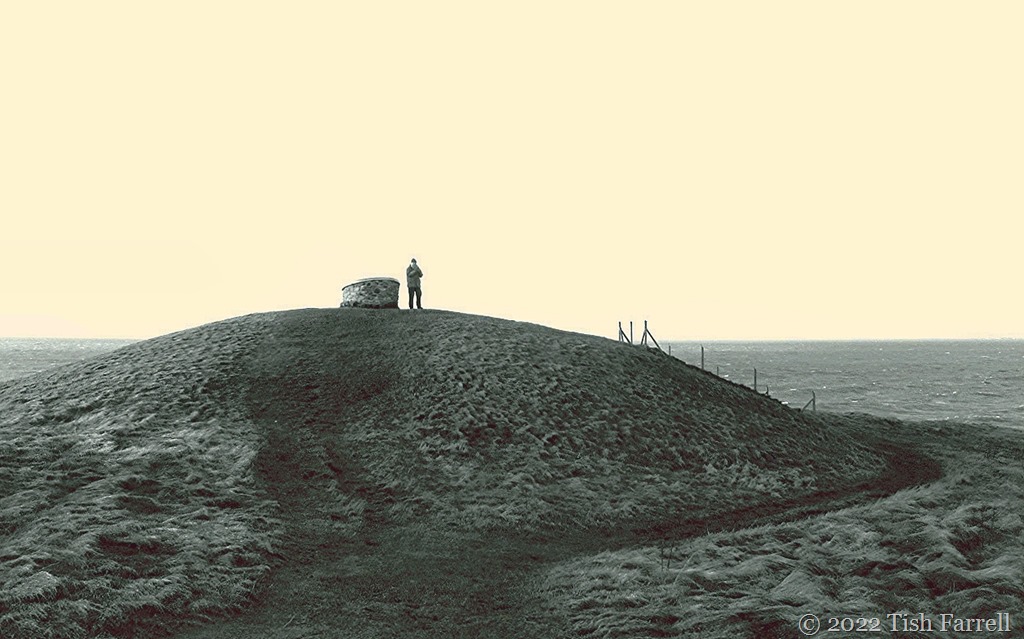
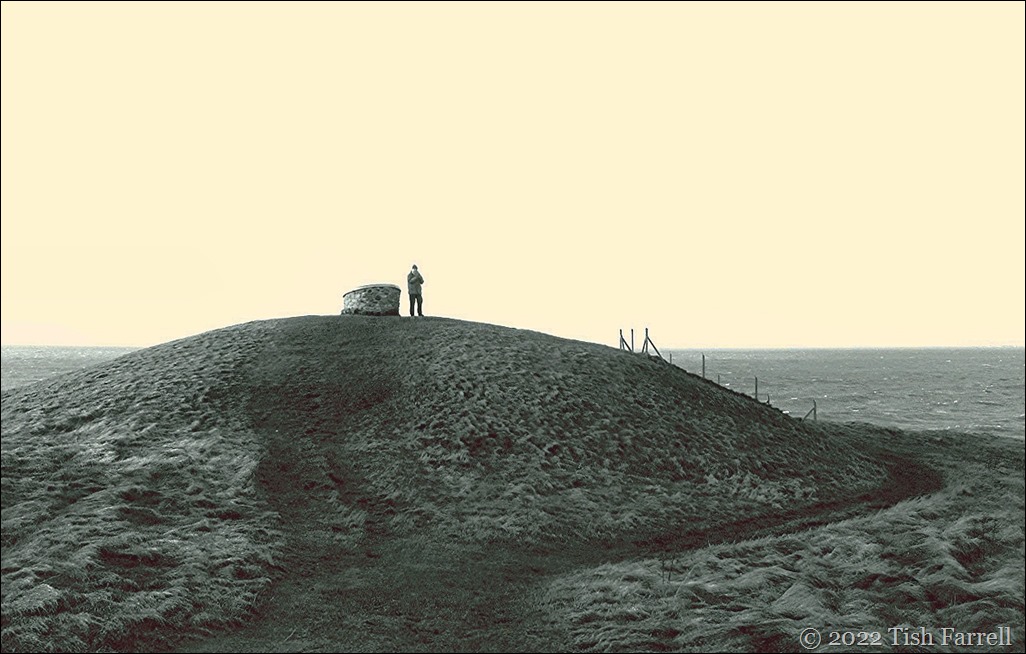
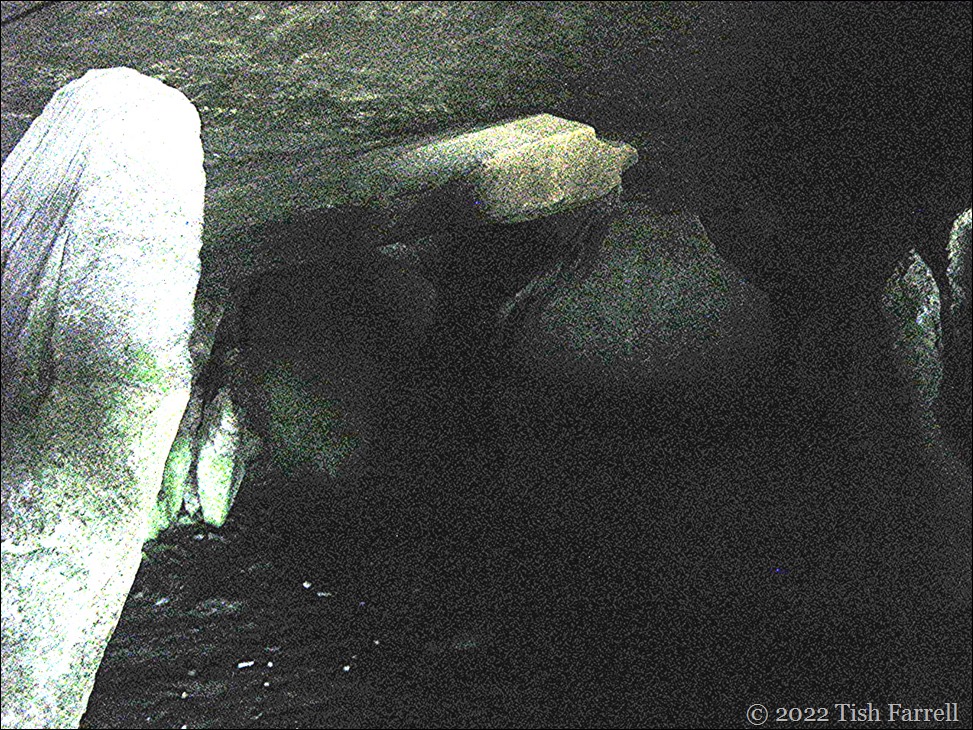
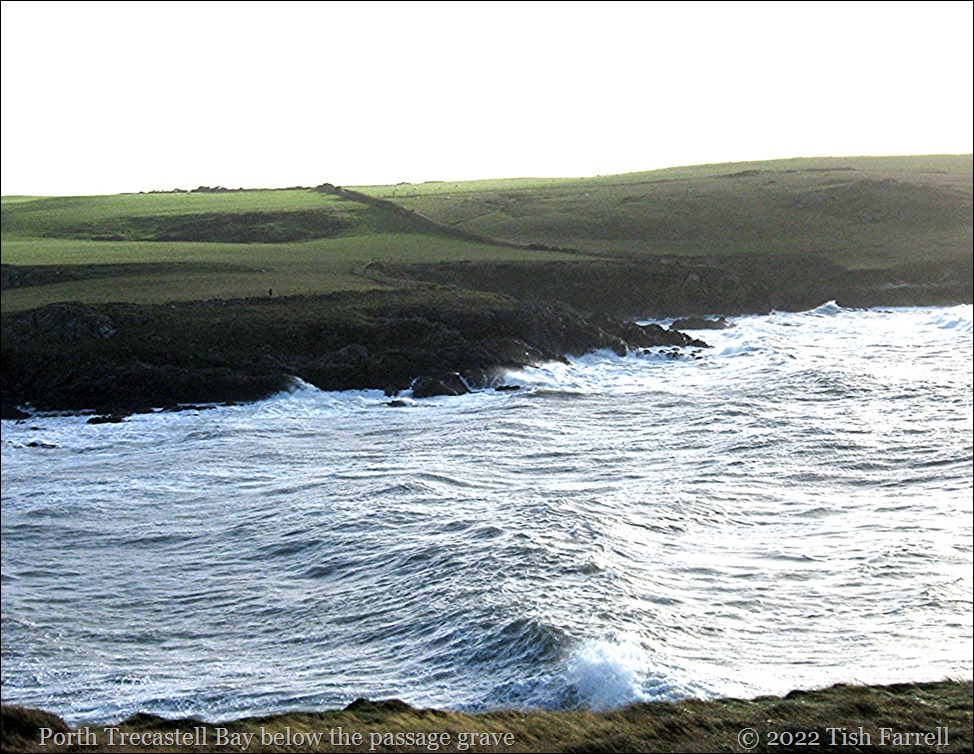
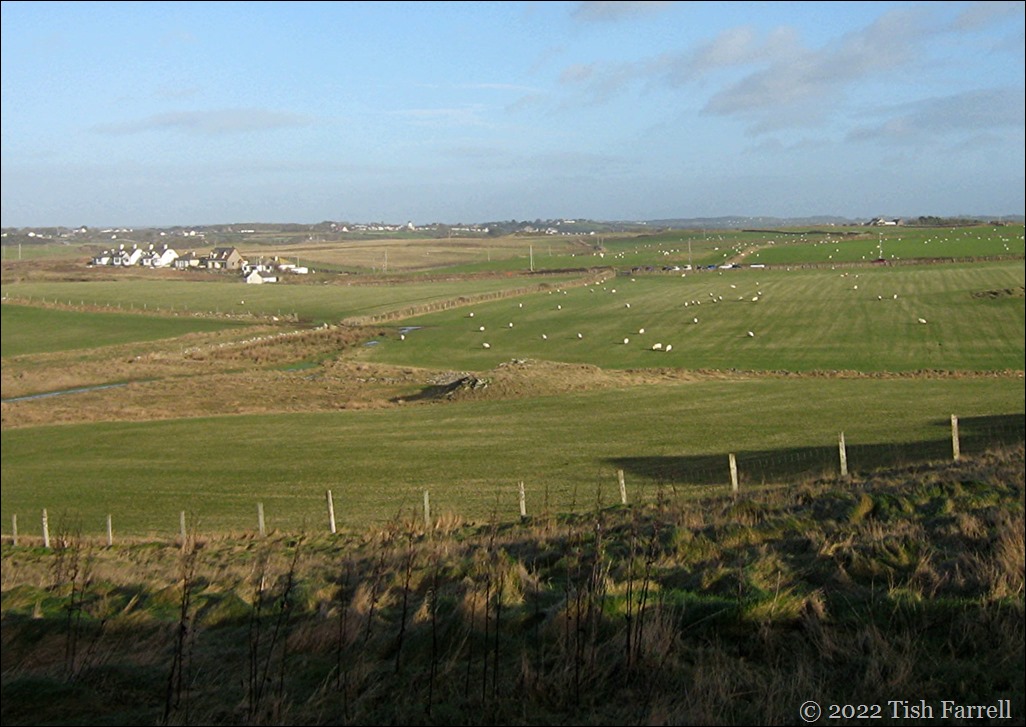
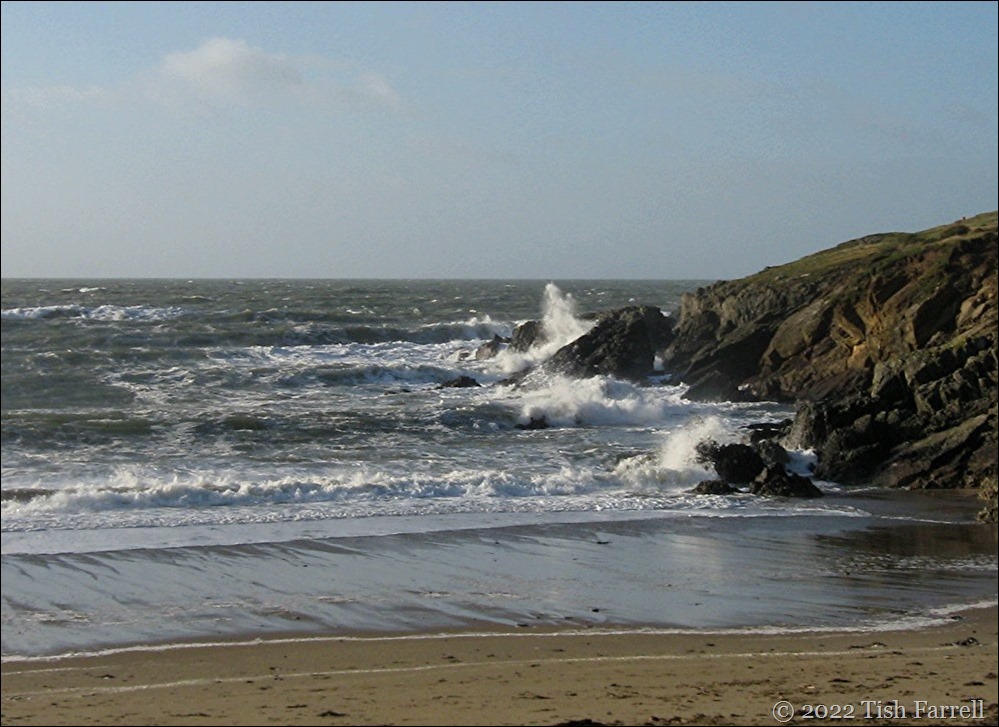
Amazing series!
Thanks, rabirius.
Whole lot of history over your way. Thanks for sharing.
Lots of remains, Beverly! 🙂
A fascinating post Tish. Thank you very much. BTW – Happy New Year:)
Happy New Year to you too, Janet.
Thanks for chronicling this story!
Thanks, Rebecca.
When I saw the heading to your post, I assumed you were going to tell a variant of the tale told about your very own Stiperstones. Which I once told in a post of mine: https://margaret21.com/2016/08/17/the-devils-journey-from-ireland-to-stiperstones/. But no! You’re still in Anglesey, and have told us so many interesting things. You really have whetted my appetite to get there again!
Spot on, Margaret. It’s a very close variant, though the details have more in common with the Wrekin’s origin tale involving a smart cobbler. The Anglesey version has a giant and giantess carrrying stones to build their house, but on meeting a cobbler and being told, as in having ‘demonstrated’ via his stash of worn-out shoes, how far away is their intended destination, they decide to drop their loads on the headland – big stones Mr. Giant, smaller stones Mrs Giant.
Love it! More entertaining than geology, although this is a science I’ve always loved.
I have huge respect for geology, though the enforced term of it for my prehistory degree almost turned me to stone.
I can imagine. I have only ever enjoyed it for fun, with no pressure.
Fascinating Tish. Thanks for this.
Happy this was of interest, Flower.
Makes me ponder on what they will dig up about our civilization 5,000 years from now. Assuming of course that there is anyone left here to do the digging…
There’ll doubtless be an awful lot of plastic. But that’s quite a big thought, Pauline.
Another Miss Tish special. Smashing post.
I am almost taking as a given you have seen the film ‘The Dig’ with Ralph Fienes?
Yes, just the other day. G. had bought it for festive viewing. A very fine film, most especially Mr. Fiennes. Happy New Year to you and yours, Ark.
Thank you, Tish,
Ditto for you and G.
Powerful magic in that tomb, Tish. I felt the chill. The lack of trees makes it even more eerie.
I agree, Tracy. These tombs are astonishing places in all manner of ways. And yes, definitely eerie.
Clever people, those ancients…most determined. Thanks for this glimpse into history
They were determined, weren’t they. One recent discovery that Stone Henge sarsen stones were recycled from a henge in Pembroke really takes the prize for ‘can do’ attitude.
Blimey, certainly was!
Remarkable Tish! I love these words, like turves and apses too. Not “everyday” for my vocation. Reminds me of Maeshowe up on Orkney, this mound. And I can’t believe in 1902 they had the gall to lay cable like that! Pshaw!
It seems it wasn’t the earliest such cable either. Even back in 1850 they were laying them. Maeshowe people were probably kinfolk (distant or not) to the Anglesey lot. The ancestors were pretty nifty voyagers.
I like the image of the Vikings discovering Maeshowe, then confounded by how to get in, destroying the top of it with their axes and hammers, peeling it open like an egg.
The swashbucklers!
A fascinating post, from the intriguing title through the detailed description and tantalising glimpse inside the barrow! Thank you 🙂
My pleasure. Thanks, Sarah.
Fascinating post Tish. I’d love to get right inside that passage grave. Really amazing.
Alison
It was a bit frustrating having a gate in the way. But it’s a good excuse for another visit – preferably without the following wind.
Fascinating post, and what a mound.
It is so easy to forget that much of what we now consider natural countryside was in fact landscaped for agricultural purposes by our ancestors
Indeed, Becky. I think Dartmoor is one dramatic case of prehistoric clearance.
and yet it feels so wild there these days!
Yes. It just goes to show – how things that look wild and unchanged have been very much ‘shaped’.
Reblogged this on Hutts Ultra Blogging World.
Thanks, Pete.
Fascinating. Lots of food for thought (not least the ingredients in that brew).
Yes, it rather conjures the Macbeth witches scene. All denizens of either land and water, but no sky representative. The snake could have connotations of immoratality. Or it could just be a very bad soup!
Yes, it conjures up the same image for me – although, as you say, it could just be bad soup… or great soup, don’t knock it till you’ve tried it!
Ha!
unusual, melancholic images and astonishing post Tish. Can give anyone chill just to feel for the story that this landscape is associated with. Thank you for sharing.
Narayan x
Thank you for telling me that this post truly hit the spot, Narayan 🙂